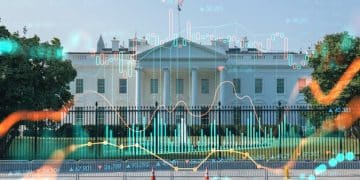Understanding the National Debt: Impact on US Economy & Future

The national debt represents the accumulation of past federal budget deficits and surpluses, influencing interest rates, inflation, and the overall stability of the US economy, with potential long-term consequences for future generations.
Understanding the **national debt** is crucial for grasping its profound effects on the US economy and the well-being of future generations. It’s not just a number; it’s a reflection of past fiscal policies and a predictor of future economic scenarios.
What is the National Debt?
The national debt, in simple terms, is the total amount of money owed by the federal government to its creditors. It’s the result of years of accumulated budget deficits, where the government spends more than it collects in revenue.
Understanding the composition and trends of the national debt is fundamental to assessing its potential impact on the US economy and future generations.
Components of the National Debt
The national debt isn’t just one big number. It comprises two main categories:
- Debt Held by the Public: This is the total amount the government owes to individuals, corporations, state or local governments, and foreign entities who have purchased U.S. Treasury securities.
- Intragovernmental Holdings: This represents the debt the government owes to its own agencies. A significant portion of this comes from Social Security and other trust funds that have invested their surpluses in Treasury securities.
The distinction between these two components is important because the economic effects can differ. Debt held by the public has a more direct impact on financial markets and interest rates.

Historical Trends of the US National Debt
The US national debt has experienced significant fluctuations throughout history, influenced by various economic events and policy decisions. Wars, recessions, and major legislative changes have all played a role in shaping its trajectory.
Examining these historical trends provides context for understanding the current state of the national debt and potential future scenarios.
Key Periods of Debt Accumulation:
- World War II: The massive war effort led to a significant surge in the national debt, as the government borrowed heavily to finance military spending.
- The Reagan Era: Tax cuts and increased military spending during the 1980s contributed to a substantial rise in the debt.
- The 2008 Financial Crisis: The government’s response to the crisis, including stimulus packages and bailouts, resulted in a sharp increase in the debt.
- The COVID-19 Pandemic: The pandemic triggered unprecedented levels of government spending to support the economy, leading to a further ballooning of the national debt.
These periods demonstrate how extraordinary circumstances can lead to significant shifts in the national debt.
How the National Debt Affects the US Economy
The national debt can exert a wide range of effects on the US economy, influencing everything from interest rates and inflation to economic growth and investment. Managing the debt effectively is crucial for maintaining economic stability and prosperity.
Let’s delve into some of the key ways the national debt impacts the economy:
Impact on Interest Rates
A large national debt can put upward pressure on interest rates. When the government borrows heavily, it increases the demand for credit, potentially driving up borrowing costs for everyone – businesses, consumers, and even the government itself.
- Higher interest rates can discourage business investment, as companies face higher costs for borrowing money to expand or modernize their operations.
- Consumers may also be less likely to make large purchases, such as homes or cars, if interest rates are high.
This can slow down economic growth.
Inflationary Pressures
In some cases, a large national debt can contribute to inflation. If the government tries to reduce the real value of the debt by printing more money, it can lead to a rise in the general price level.
In conclusion, the national debt can significantly influence interest rates, inflation, and overall economic stability.

The Debt Ceiling and Government Shutdowns
The debt ceiling is a legal limit on the total amount of money the US government can borrow to meet its existing obligations. When the debt reaches this limit, Congress must raise or suspend the ceiling to allow the government to continue borrowing.
Failure to do so can lead to a government shutdown and potentially even a default on the national debt.
The Potential Consequences of a Debt Default
A debt default would be catastrophic for the US economy. It could trigger:
- A sharp increase in interest rates
- A plunge in the value of the dollar
- A loss of confidence in the US government’s ability to manage its finances
The risk of default is one of the most serious consequences of a high national debt.
The National Debt and Future Generations
The national debt doesn’t just affect the current economy. It also has implications for future generations, who will ultimately be responsible for paying it down.
Understanding the burden placed on future generations is crucial for making responsible fiscal decisions today.
The Opportunity Cost of Debt
The resources used to pay down the national debt could otherwise be invested in things that benefit future generations, such as:
- Education
- Infrastructure
- Research and development
A high national debt can limit these investments, potentially slowing down future economic growth and reducing the standard of living for future generations.
Strategies for Managing the National Debt
There are several different approaches to managing the national debt, each with its own set of advantages and disadvantages. These include spending cuts, tax increases, and economic growth initiatives.
Finding the right balance between these strategies is essential for achieving sustainable debt management.
Fiscal Policy Options
Governments can implement various fiscal policies to address the national debt. Here are a few common strategies:
- Spending Cuts: Reducing government spending on various programs and services can help lower the budget deficit and slow the growth of the national debt.
- Tax Increases: Raising taxes can increase government revenue, which can be used to pay down the debt.
- Economic Growth Initiatives: Policies that promote economic growth can increase government revenue and make it easier to manage the debt.
These strategies offer different pathways to address the challenges posed by the national debt.
Conclusion
Understanding the national debt, its causes, its effects, and the various strategies for managing it is crucial for informed citizens and policymakers alike.
| Key Point | Brief Description |
|---|---|
| 💰 Debt Definition | Total money owed by the US federal government. |
| 📈 Economic Impact | Affects interest rates, inflation, and economic growth. |
| ⚠️ Debt Ceiling | Legal limit on the total amount the US government can borrow. |
| 世代 Future Generations | Will ultimately be responsible for paying down the national debt. |
Frequently Asked Questions
▼
A deficit occurs when the government spends more money than it brings in through revenue in a given year. The debt is the accumulation of all past deficits, minus any surpluses.
▼
A high national debt can put upward pressure on interest rates as the government borrows more money, increasing demand for credit. This can make borrowing more expensive for businesses and consumers.
▼
The debt ceiling is a legal limit on the total amount of money the US government can borrow to meet its existing obligations. Congress must raise or suspend it to avoid a potential default.
▼
Future generations will ultimately be responsible for paying down the debt. The resources used to do so could have been invested in education, infrastructure, and research and development.
▼
Strategies for managing the national debt include spending cuts, tax increases, and policies that promote economic growth. A balanced approach is often the most effective.
Conclusion
Understanding the national debt is essential for every informed citizen. By knowing its intricacies and implications, we can engage in meaningful discussions and advocate for responsible fiscal policies that benefit both current and future generations.





